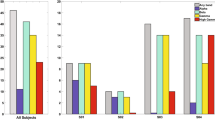Summary
The cortical somatosensory evoked potential (SEP) of the rat, evoked by contralateral forepaw stimulation, consisted of early (P 1 and N 1) and late components (P 2 and N 2). Microelectrode recording yielded evoked unitary responses of short latencies in the range of the early components and responses of longer latencies in the range of P 2. During the development of focal epilepsy after topical application of penicillin, the late components of SEP were enhanced and the enhanced late negativity corresponded to a surface negative cortical spike. The prominent enlargement of later components was associated with prolonged, often recurrent discharges of longer latency unitary responses and with enlarged local field potentials. Early components of SEP remained relatively unaffected and so did unitary responses with short latencies.
Epileptic spike-conditioned SEPs in the cuneate nucleus, thalamic sensory relay nucleus and sensory cortex were depressed from 100 ms (cuneate nucleus) to about 300 ms (thalamus and cortex) subsequent to spike discharge. Transmission in the cuneate nucleus was least affected. Thalamic and cortical early components of SEP had similar time courses of recovery, which differed markedly from that of cortical late components. Our findings suggest that two different neuronal activities generate different components of SEP and are differentially involved in the epileptic activities, which results in the different amplitude recovery following spontaneous epileptic spike discharges.
Zusammenfassung
Corticale, durch elektrische Vorderpfotenreizung evozierte somatosensorische Potentiale (SEP) der Ratte bestehen aus früzhen (P 1 und N 1) und späteren (P 2 und N 2) Komponenten. Mikroelektrodenableitungen ergeben unter denselben Reizbedingungen Einzelneuronenantworten kurzer und längerer Latenzen synchron mit den frühen (P 1, N 1) bzw. späten Komponenten (P 2).
Im Verlauf einer durch topische Penicillin-Applikation erzeugten Focalepilepsie vergrößern sich nur die Amplituden der späten SEP-Komponenten. Mit der Größenzunahme der späten Komponenten verlängert sich die Entladungsdauer der Einzelneuronenantworten entsprechender längerer Latenzen. Die frühen SEP-Komponenten und die entsprechenden Einzelneuronenantworten kurzer Latenz bleiben unverändert. Im Cortex und in den sensorichen Relaisstationen (N. cuneatus, spezif. Kern des Thalamus) werden von 100 (N. cuneatus) bis zu 300 ms (Thalamus und Cortex) nach einem epileptischen Spike die somatosensorischen Potentiale partiell oder komplett unterdrückt. Der zeitliche Verlauf der Normalisierung der Amplituden ist für die frühen Komponenten thalamischer und corticaler SEP gleich, jedoch gegenüber den späteren corticalen Komponenten initial rascher.
Unsere Befunde berechtigen zur Annahme zweier Gruppen somatosensorischer corticaler Neuronaktivität, deren Erregung frühe bzw. spätere Komponenten des SEP erzeugt und die unterschiedlich vom epileptogenen Agens beeinflußt werden.
Similar content being viewed by others
References
Anderson P, Eccles JC, Schmidt RF, Yokota T (1964) Slow potential wave produced in the cuneate nucleus by cutaneous volleys and by cortical stimulation. J Neurophysiol 27:78–91
Angel A, Berridge DA, Unwin J (1973) The effect of anesthetic agents on primary cortical evoked responses. Br J Anaesth 45:824–836
Angel A, Lemon RN (1974) An experimental model of sensory myoclonus produced by 1,2-dihydroxybenzene in the anesthetized rat. In: Harris P, Mawdsley C (eds) Epilepsy. Proc. of the Hans Berger Centenary Symposium. Churchill Livingstone, Edinburgh London New York, pp 37–47
Dawson GD, Holmes O (1966) Cobalt applied to the sensorimotor area of the cortex cerebri of the rats. J Physiol (London) 185:455–470
Gastaut H, Hunter J (1950) Le phénomène de l'alternance dans les rhythmes induits par la stimulation lumineuse intermittente sur le cortex optique strychninisé. J Physiol (Paris) 42:592–596
Holubár J (1966) Different modes of activation of the penicillin and mirror cortical foci in rats. In: Servit Z (ed) Comparative and cellular pathophysiology of epilepsy. Exc. Med. Int. Congr. Ser. Amsterdam
Matsumoto H, Ajmone-Marsan C (1964) Cortical cellular phenomena in experimental epilepsy: interictal manifestations. Exp Neurol 9:305–326
Mountcastle VB, Davies PM, Berman AL (1959) Response properties of neurons of cat's somatic sensory cortex to peripheral stimuli. J Neurophysiol 20:374–407
Noebels JL, Prince DA (1978) Development of focal seizures in cerebral cortex: Role of axon terminal bursting. J Neurophysiol 41:1267–1281
Pellegrino LJ, Cushman AJ (1967) A stereotaxic atlas of the brain. Appleton-Century-Crofts, New York, pp 1–81
Petsche H, Rappelsberger P, Frey S (1971) Intrakortikale Mechanismen bei der Entstehung der Penicillinspitzen. EEG-EMG 2:176–180
Prince DA (1966) Modification of focal cortical epileptogenic discharge by afferent influences. Epilepsia (Amsterdam) 7:181–201
Sherwood NM, Timiras PS (1970) A stereotaxic atlas of the developing rat brain. Univ. of Calif. Press, Berkeley
Schwarzkroin PA, van Duijn H, Prince DA (1974) Effects of projected cortical epileptiform discharge on field potentials in the cat cuneate nucleus. Exp Neurol 43:88–105
Schwarzkroin PA, Mutani R, Prince DA (1975) Orthodromic and antidromic effects of a cortical epileptiform focus on ventrolateral nucleus of the cat. J Neurophysiol 38:795–811
Therman PO (1941) Transmission of impulses through the Burdach nucleus. J Neurophysiol 4:153–166
Author information
Authors and Affiliations
Additional information
This work was supported by the Deutsche Forschungsgemeinschaft (German Research Council)
Rights and permissions
About this article
Cite this article
Takahashi, H., Straschill, M. The effects of focal epileptic activity on the somatosensory evoked potentials in the rat. Arch Psychiatr Nervenkr 231, 81–91 (1981). https://doi.org/10.1007/BF00342832
Received:
Issue Date:
DOI: https://doi.org/10.1007/BF00342832




